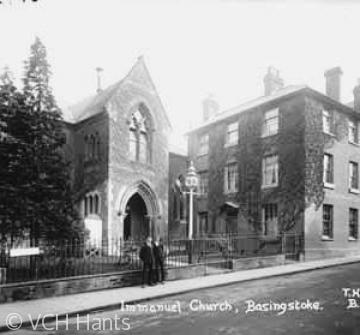‘Liturgical and Congregational’: The Countess of Huntingdon’s Connexion Church in Basingstoke c1755 to 1969

For over 200 years, one of the most distinctive features of Basingstoke’s ecclesiastical landscape was a Countess of Huntingdon’s Connexion church. Founded in the mid 1750s and situated in Wote Street from at least 1802 it was known as Immanuel Church from 1894. The Church was a legacy of the Evangelical Revival of the 18th century. Indeed, as far Basingstoke was concerned, it was, in many ways, the only immediate consequence since Methodism did not get established in the town until well into the 19th century.
With respect to its characteristics, the Connexion is an interesting hybrid. Put simply, it shared with Methodism its Evangelical roots; it subscribed to the Anglican liturgy; and it adopted an Independent/Congregational approach to church governance. Interestingly, the original trust deed for the Basingstoke Church required the Book of Common Prayer to be used at services and although this requirement was eventually dropped the Church continued to promote itself on the basis of its ‘liturgical services’. Moreover, a number of its ministers subsequently joined the Church of England while others served Congregational as well as Connexion churches.
In many respects, the fortunes of the Church reflected the personality, preaching style and theological stance of its ministers. They included the Revd Benjamin William Adams, minister from 1884 to 1890 and ‘a gentleman of genial and cultured presence’; the Revd Dr James Barnes (1893-1895), who was described as ‘an ardent evangelist, carrying the message of the Gospel, and … fill[ing] the Church almost to suffocation every Sunday’; the Revd Eustace Long (1899-1906), ‘a thoughtful preacher, a sympathising Pastor, and an instructive teacher’; the Revd William Schofield Thomson (1907-1915), who at his departure was praised for his ‘staunch adherence to the orthodox faith and his kind and efficient ministry’; the Revd Edwin Tully (1920-1931), whose ministry was characterised as ‘ten happy years’; the Revd Arthur Sansom (1932-1943), who displayed the qualities of ‘sincerity, earnestness and sanctified commonsense … [as well as] the saving grace of humour’; and the Revd Sidney George Woodget (1951-55) remembered as a man with ‘a loving, caring pastoral nature’.
In many respects, the life of Immanuel was similar to that of other Nonconformist churches in Basingstoke. As well as the regular Sunday services and those for special occasions, over the years the Church sponsored a range of satellite organisations, including a Sunday school and a branch of the Young People’s Society for Christian Endeavour. Another vital strand in the life of Immanuel was that of music, both sacred and secular, with a notable feature of its musical tradition being, for many years, an annual performance of Stainer’s Crucifixion at Eastertide. Social events were arranged on a regular basis often with the aim of raising funds for improvements to the fabric of the church premises, which underwent a considerable number of changes. The Church was also privileged to host the 100th and 111th anniversary conferences of the Countess of Huntingdon’s Connexion in 1922 and 1933 respectively.
Although services continued to be held on a regular basis in the years following the Second World War and the Church was served by three full time, if in two cases elderly, ministers, membership slowly decreased. To what extent a younger, and arguably more energetic, minister would have been able to revive the cause must remain an open question. Undoubtedly Immanuel suffered, perhaps more than many churches, from the general decline in churchgoing and the inexorable march of secularisation. The end came in 1969, when the church premises were demolished, a casualty of the redevelopment of the town centre. This was undoubtedly a sad fate for one of Basingstoke’s longstanding places of worship.
(For the source of the quotations please see the asset)
Roger Ottewill
June 2018
Content derived during research for the new VCH Hampshire volume, Basingstoke and its surroundings.


